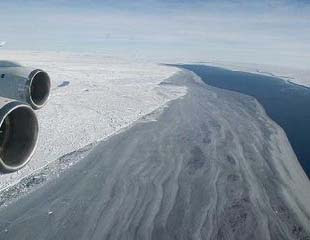
NASA's DC-8 airborne science laboratory has completed its 2011 Operation IceBridge science flights over Antarctica, and arrived home at its base in Palmdale, Calif., Nov. 22. The IceBridge flight and science team flew a record 24 science flights during the six-week campaign, recording data from a suite of sophisticated instruments on the thickness and depth of Antarctic ice sheets and glacial movement The aircraft departed its deployment base at Punta Arenas, Chile, Tuesday morning Nov. 22 and after a refueling stop in Santiago, Chile, set course for Los Angeles International Airport for customs clearance. The flying lab continued on to the Dryden Aircraft Operations Facility in Palmdale, arriving about 8:30 p.m. that evening after almost 15 hours in the air.
A highlight of the IceBridge mission was the discovery during a low-level overflight Oct. 14 of a large crack that had recently begun across the Pine Island Glacier ice shelf, a precursor to the separation of an estimated 310-square-mile iceberg into the ocean in the near future. The growth of the estimated 18-mile-long rift was documented on several subsequent flights The final science flights on Nov. 17 and 19 focused on the middle of the Antarctic Peninsula and the George VI Sound on the peninsula's western side.
Mission manager Chris Miller's report on the former noted that clear weather over the eastern side of the peninsula provided "a rare opportunity to collect data over glaciers that are more regularly shrouded in cloud." The mostly clear weather allowed the science team to collect data at low altitudes of only 1,500 feet above ground for almost seven hours out of the more than 11 hours the team was aloft.
A highlight of the IceBridge mission was the discovery during a low-level overflight Oct. 14 of a large crack that had recently begun across the Pine Island Glacier ice shelf, a precursor to the separation of an estimated 310-square-mile iceberg into the ocean in the near future. The growth of the estimated 18-mile-long rift was documented on several subsequent flights The final science flights on Nov. 17 and 19 focused on the middle of the Antarctic Peninsula and the George VI Sound on the peninsula's western side.
Mission manager Chris Miller's report on the former noted that clear weather over the eastern side of the peninsula provided "a rare opportunity to collect data over glaciers that are more regularly shrouded in cloud." The mostly clear weather allowed the science team to collect data at low altitudes of only 1,500 feet above ground for almost seven hours out of the more than 11 hours the team was aloft.